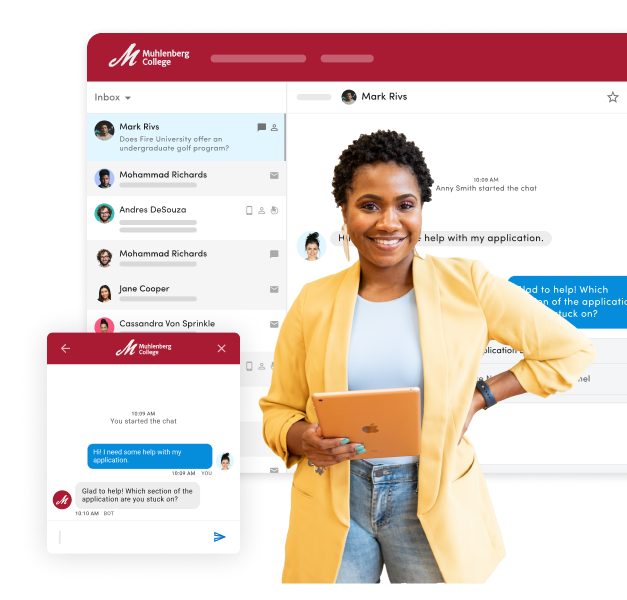2024 Guide: What is Student Success in Higher Education?
by Sirley Carballo · Updated Sep 13, 2024

What is Student Success in Higher Education?
Depending on where you look, the meaning of student success varies wildly. From professors, to parents, to students themselves, being successful in higher education depends on many factors, personal traits, and the level of institutional support.
Although this variance makes it tough to pin down a definition that works in every instance, it is possible to establish commonalities in situations and on campuses where students are thriving. Such success has never been more important, given the growing skepticism that many students face when taking on substantial commitments and financial debt. With these considerations in mind, colleges and universities must strive to create environments where success is attainable—and expected.
In this post, we’ll take a high level overview of what it means to encourage and promote student success at your school. We’ll also explain how student engagement and personalization play into the long-term picture for modern students.
Definition of Student Success in Higher Education Institutions
Defining student success relies on the two very important things—metrics and student perception. While administrators use measurements like GPA (grade point average), attendance, and exam scores to gauge success numerically, students might have a different point of view.
For the college learner, being a successful student also includes qualities related to support, persistence, community involvement, and interpersonal (as well as academic) experiences.
As a result, we know that student success is more than just a number with a few decimals; instead, it’s the comprehensive way that students perform and persist.
As colleges and universities have navigated more challenging enrollment environments over the past few years, coming up with a concrete definition of success has become more essential. To help with this goal, EDUCAUSE assembled a panel of higher ed leaders and experts who created the following working definition of student success:
“Student success community programs promote student engagement, learning, and progress toward the student's own goals through cross-functional leadership and the strategic application of technology."
If, as educators or higher education professionals, we follow this path to student academic achievement, then we must acknowledge and embrace the role of engagement in success.
>> Explore our Full Guide to Student Success in Higher Education <<
Success vs. Persistence—What’s the Difference?
Educators—and even lawmakers—have studied student success efforts over time. In fact, this attention has contributed to major policies and financial incentives, including the use of Pell Grants and the Stafford Student Loan Program. Most academic (and even political) leaders know that in order to succeed, students need the right building blocks.
These factors are both personal (found within the individual student) and holistic (taking place broadly in society at large). In other words, the student must have the emotional and academic intelligence needed to move forward, but external factors are bound to influence the likelihood and possibility of attaining a degree.
Success paves the way for persistence in college, which means that students finish and complete their degree program of choice.
Finding Success in College? Know the Facts
For leaders in higher education, fostering student success depends on knowing what uphill battles exist in the world of post-secondary learning.
When it comes to the experiences of university applicants and attendees, it’s not as simple as “show up, earn good grades, and win.” Oversimplifying the process ignores one of the biggest problems in today’s higher education climate, namely that up to 50% of students are stalling out before they achieve a four-year degree in that exact timeframe.
Successful degree completion also has implications for future career success. In a survey of thousands of institutions throughout the United States, data shows that college degree earners out-earn high school graduates over the course of their respective careers. And while debt from student loans continues to be a pressing issue across the country, knowing how to help students successfully achieve a degree while preparing for the future is critical, especially in a competitive and ever-changing higher ed climate.

Top 6 Recruiting and Engagement Challenges—and How to Beat Them
We’ve rounded up remedies to six of the challenges our partner schools experience most and the actionable tips you need to overcome them.
Get the Guide
Tips to Improve Student Success in Higher Education
Are you eager to take your student success campaigns from good to great? There are several steps and methods you can use to get there. As you apply these tips, remember that it’s not just about creating an impressive campus—it’s about empowering students to accomplish what they set out to do when they first enrolled.
Get to Know Your Students
In order for students to succeed, they must feel like more than just a number. This is especially true at larger institutions that enroll tens of thousands of students at one time. In such a large environment (often with large class sizes), it’s easy to feel swallowed up in the experience.
Gather background information on each and every student that enrolls. What personal strengths do they bring upon enrollment? Are there any “red flags” or things to know that might contribute to stumbles along the path to a degree? Encourage your admissions and enrollment officers to ask the right questions and upload as much data as possible to the student’s record within your CRM.
Match Students to the Appropriate Resources
Once you know your students well, you can personalize the kind of resources that they receive during their time on campus. Since every student’s needs and challenges are unique, this might look like facilitating different opportunities based on areas of struggle.
- Financial - support students who need advice on payments, loans, and scholarships
- Academic - guide students that struggle to maintain academic performance
- Social - foster positive relationships on campus that help students feel connected
- Mental - work with students on mental health concerns (like stress and anxiety) that could prevent them from reaching their full potential
- Physical - give options for healthy living with on-campus meals and activities
Each of these resources plays an important role in developing successful student outcomes. Even if some students explore one specific resource option over the others, creating an environment of holistic support can be a gamechanger.
Assist Throughout the Student Lifecycle
One mistake that schools often make is placing the majority of student-centered resources at the start of the process. And yes, while helping students get through the enrollment gate is important, it’s not enough to only provide support during those first few months.
Persistence and success are both long-term goals, meaning that it takes years to see or personally witness the benefits. As a result, campuses need to create a multi-layered approach to the student journey, not simply at the beginning and end of a degree.
Practically, this looks like having an engaged academic advising team that monitors student progress along the way. The process might also involve peer mentors who develop supportive relationships with students who are slightly behind or exhibiting red flags.
Support a Growth Mindset
More recently, schools and researchers have explored the intrinsic qualities of successful students. For some, it’s as simple as owning a mindset of growth. In other words, there are things that students won’t know or excel at right away, and that’s normal.
A growth mindset also encourages students who might express hesitance over taking classes that don’t directly contribute to their degree program. This is especially true at liberal arts colleges, where students must complete several core courses unrelated to their field of study.
Helping undergraduate students see the value in these core pieces can help them stay more engaged and find success, even through the duration of a four-year program. Overall, this encouragement is more likely to boost student satisfaction and improve academic success.
How to Measure Student Success
Measuring student success isn't only critical for students with big dreams. Keeping accurate metrics on student outcomes and student progress also protects institutions in a public capacity as well. When institutions better understand how students actually perform year-over-year, they can better support marginalized students, equip or train faculty members, and improve the holistic student experience.
Finding tangible stats also identifies where it's possible to deliver personalized support to students and match them with appropriate resources for retention. These calculations can close the achievement gap and provide more data points with which to enhance academic programming over time.
There are a variety of metrics for measuring student success. The below are simply a snapshot of those that bring campus leaders, instructors, and advisors on the same page to help more students excel.
Retention Rates
Retention rates are leading indicators for how well students are doing on the path to degree completion. Retention rates easily calculate the percentage of students who return to the same institution for a subsequent year of study. Many institutions rely on retention rate to make critical changes in programming, to reallocate funding or financial support, or to invest in tools for improved engagement.
The retention rate (expressed as a percentage) can be found by dividing the number of students retained (in a defined cohort) by the total number of students in the same cohort or group.
Graduation Rates
Graduation rates measure the percentage of students who complete their chosen studies within a set timeframe. To rate student progress over time, most colleges define a complete undergraduate degree program as one that concludes in four to five years. Post-graduate degrees are often shorter in duration.
The graduation rate (expressed as a percentage) can be found by dividing the number of students who graduate (in a defined cohort) by the total number of students in the same cohort or group, regardless of graduation status.
Post-Graduation Employment Rate
Post-graduation employment measures the percentage of graduates who acquire full-time employment in their field of study. Other career outcomes that are relevant in this calculation include the average salary earned or the amount of time taken to secure employment post-graduation.
By analyzing post-graduation employment metrics, institutional leaders can determine the effectiveness of their academic programs as they relate to modern labor demands. This is particularly relevant for academic advising offices that strive to use coursework, mentorship, and professional training to prepare graduates for the workforce.
Student Support Services Utilization Rate
Student support services might include counseling, tutoring, and career services. By tracking the use of these services, institutions can identify the students (including first generation students and international attendees) who require additional support or advice.
Colleges and universities can also use utilization data to analyze the effectiveness of support channels and make improvements for future cohorts. Student success initiatives are always most impactful when time, energy, and resources are being invested in the right places and in ways that have the most value for real students.
Qualitative Alumni and Student Surveys
Not every aspect of the college experience can be boiled down to a single number, which is why listening to real student voices is also critical.
Colleges and universities can conduct surveys to qualitatively learn about student satisfaction, engagement, and sense of belonging. To better define student success, survey creators may even poll students on what that concept specifically looks like to them in practice.
Qualitative experience metrics identify areas where students require a personalized approach to learning. Moreover, alumni questionnaires offer insights into how the institution prepares students for their future endeavors in ways that go beyond basic exam scores.
How Does a Student Engagement Platform Promote Student Success?
A student engagement platform offers more insight into the actual lives and needs of individual students. This is in contrast to grouping all students together in one massive cohort and applying a blanket approach with hope that they’ll eventually succeed.
Modernized engagement platforms like Element451 also allow schools to deliver the following elements to students along the journey.
- Personalized messages for real-world questions
- Targeted communications that assist with reminders and deadlines
- Automated responses for speedy answers (when they’re needed and warranted)
- Engaging content that creates well-rounded campus experiences overall
If modern student enrollment is changing, our approach to fostering success (alongside student retention) must keep pace. As schools grow and change, it’s very difficult to accomplish this manually or without the appropriate digital experiences. A student engagement platform closes the gaps and ensures that every student receives a fair shot at success.

Get a Demo of Element451
Student enrollment is changing. Now’s the time to adapt and change your enrollment strategy to be student-centered.
See it in Action
Help Your Students Define Success
To encourage the success of college students on your own campus or within a specific population, you need to see the full picture. Investing in engagement is one proven way to make the year count—both for your administrative team and for any students who embark on their post-secondary career.
Element451 can help you achieve these outcomes on both the campus and student level. With personalized campaigns and individualized experiences that help your school stay competitive, you’ll be able to quickly leverage tools that make a tangible difference.
Together, let’s help students achieve what they set their minds to this year—and beyond.

About Element451
Boost enrollment, improve engagement, and support students with an AI workforce built for higher ed. Element451 makes personalization scalable and success repeatable.
Categories
New Blog Posts

The Definitive Guide
AI in Higher Education
Bridge the gap between the latest tech advancements and your institution's success.
Useful Links

Talk With Us
Element451 is the only AI Workforce Platform for higher education. Our friendly experts are here to help you explore how Element451 can improve outcomes for your school.
Get a Demo








